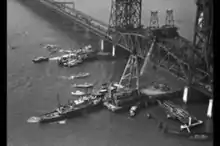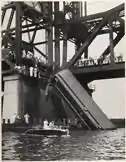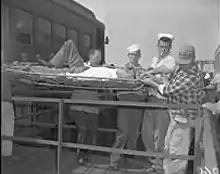Newark Bay rail accident
The 1958 Newark Bay rail accident occurred on September 15, 1958 in Newark Bay, New Jersey, United States, when a Central Railroad of New Jersey (CNJ) morning commuter train, #3314, ran through a restricting and a stop signal, derailed, and slid off the open Newark Bay lift bridge. Both diesel locomotives and the first two coaches plunged into Newark Bay and sank immediately, killing 48 people and injuring the same number.[1] A third coach, snagged by its rear truck (bogie), hung precariously off the bridge for two hours before it also toppled into the water. As the locomotive crew was killed, the cause of the accident was never determined nor reinvestigated.


| 1958 Newark Bay rail accident | |
|---|---|
 The Central Railroad of New Jersey Newark Bay Bridge connected Bayonne and Elizabeth, seen in the distance. | |
| Details | |
| Date | September 15, 1958 10:01 am EDT |
| Location | Newark Bay, Bayonne, New Jersey, U.S. |
| Coordinates | 40.6545°N 74.15°W |
| Country | United States |
| Line | Central Railroad of New Jersey main line |
| Operator | Central Railroad of New Jersey |
| Incident type | Derailment into water |
| Cause | Signal passed at danger |
| Statistics | |
| Trains | 1 |
| Deaths | 48 |
| Injured | 48 |
Conditions
There were three signals spaced at three-quarters of a mile, a quarter of a mile, and 500 feet (150 m) from the lift bridge, and an automatic derailing device fifty feet beyond the third signal. The bridge span had to be down and locked electrically before the signals and derail devices could be cleared for movement on the track. Conversely, all the devices had to be in their most restrictive positions before the bridge could be unlocked and raised. The train ran through two signals and immediately derailed; the automatic derailer was designed to knock the wheels off the track so that the resistance of the ties and ballast against the train's wheels would bring a slow-moving derailed train to a stop. Train #3314, although derailed, was moving at such a great speed that it did not have sufficient distance to stop before diving off the bridge.
Causes

The Interstate Commerce Commission (ICC), the New Jersey Public Utilities Commission, and the United States Army Corps of Engineers each conducted separate inquiries into the wreck, and all three found that the absence of a "dead man's control" was one primary cause of the accident. After the inquiries, the New Jersey Public Utilities Commission ordered the railroads to install such devices on all passenger locomotives operating in New Jersey. Some CNJ locomotives were equipped already with such devices, but this did not include the engine leading Train #3314 (a EMD GP7 No. 1532) on the day of the wreck. The CNJ claimed that such a device was not always necessary, because all their trains had two crewmen in the locomotive cab. If the engineer was incapacitated somehow, the fireman would assume control of the locomotive.
An autopsy found that the engineer, 63-year-old Lloyd Wilburn, had indications of hypertensive heart disease, but that he had died of asphyxia due to drowning. However, no reason could be found to explain why fireman Peter Andrew, 42, could not or did not stop the train. Investigators raised the wreckage and did not find any defect of the braking system on the locomotives and coaches; it was also determined that the signal system and derailing device on the bridge had functioned properly. Lacking more definitive evidence, it was presumed that the engineer had somehow become incapacitated in the cab and the fireman failed to take appropriate action to stop the train. The presence of a dead man's control in the locomotive cab might have averted the catastrophe, and, while the ICC only "recommended" the installation of these devices, the New Jersey Board of Public Utilities directed that the railroad install them in all of its locomotives.
Aftermath
At least 48 people died in the wreck, including former New York Yankees second baseman George "Snuffy" Stirnweiss and James Carmalt Adams, the brother-in-law of author Kurt Vonnegut.[2][3][4] The CNJ faced a number of legal actions which were all settled out of court. The two locomotives, #1532 and #1526, were raised, rebuilt by the Electro-Motive Division of General Motors (EMD) and returned to service. Locomotive #1532 retained its original number, while the #1526 was renumbered #1531. They served primarily as freight locomotives, although #1532 was photographed in passenger service after its return from EMD. The Newark Bay lift bridge was used until the last passenger train left Bayonne's Eighth Street Station on August 6, 1978.[5] Demolition of the central lift spans began in July 1980 after the United States Coast Guard declared the structure a navigational hazard to ships.[6] The trestle and approaches were removed in 1987–1988 when it became apparent that a replacement span was no longer feasible. Removal of the piers began in 2012.[7]
References
- The Coast Guard helped with rescuing 43 survivors and recovering 29 bodies according to "Daily Chronology: September" (PDF). United States Coast Guard. Retrieved April 21, 2009.
- New York Times articles about Snuffy Stirnweiss's death, reproduced at The Dead Ball Era website. Retrieved on October 13, 2013.
- Heininger, Claire (September 15, 2007). "Looking Back: 48 killed as train plunges off Newark Bay drawbridge – NJ.com: Star-Ledger updates". The Star-Ledger. Retrieved April 18, 2009.
- Haine, Edgar A. (1993). Railroad Wrecks. Associated University Presses. p. 134. ISBN 0-8453-4844-2. Retrieved April 18, 2009.
- Thorpe, Steve. "CONRAIL/NJ D.O.T. Draws the Curtain on the Bayonne Shuttle". Archived from the original on October 7, 2011. Retrieved 23 April 2009.
- ">"X. HISTORIC PRESERVATION PLAN ELEMENT" (PDF). Archived from the original (PDF) on July 5, 2008. Retrieved April 18, 2009.
- http://www.nj.com/bayonne/index.ssf/2012/02/army_corps_of_engineers_removi.html
- Slapstick (novel), a novel by Kurt Vonnegut; the wreck is referenced in the novel as the cause of death of his brother-in-law two days before his sister's death from cancer, leaving their four children suddenly orphaned
External links
- "CNJ Newark Bay Draw Wreck (book for sale)". Tri-State Railway Historical Society, Inc. Archived from the original on May 5, 2009. Retrieved April 18, 2009.
- "Remnants of demolished CRRNJ Newark Bay Bridge, Bayonne New Jersey". Retrieved April 18, 2009.
- "Central Railroad Bridge of New Jersey Newark Bay Bridge". bridgesnyc. Retrieved June 3, 2015.